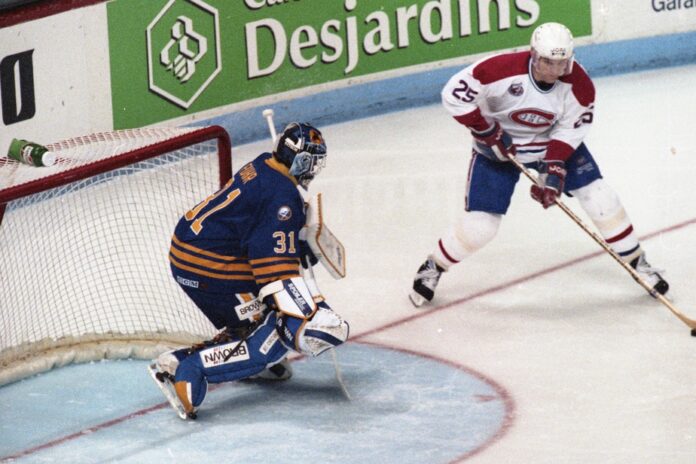I wonder why we are waiting to induct Vincent Damphousse and Claude Lemieux into the Hockey Hall of Fame, when Eric Lindros is already there. Lemieux won the Stanley Cup with three different clubs as well as the Conn-Smythe Trophy in 1995, and Damphousse had 1,205 points, far more than Lindros (865), and won the Stanley Cup in 1993.
There are two ways to answer this question. First, we must remember that the choice of players inducted into the Temple is not an exact science. It depends on the tastes and preferences of the members of the selection committee. Look at the time that Pierre Turgeon had to wait. Then, it is important to underline how Lindros was a dominant player with the Philadelphia Flyers in the 1990s: 659 points in 486 games from 1992 to 2000. This earned him the Hart Trophy in 1995 and a citation the next year. Damphousse and Lemieux did not leave this mark.
It’s hard to compare eras, but I have discussions with a 20-year-old colleague who says Connor McDavid is the greatest of all time. Technically, it’s obvious that today’s players are better than in the past, but you have to consider the eras. Gretzky, at his peak, won the scoring championship by 75 points, while McDavid won it by just 25 points. Who is right ? Is there an advanced stat that can separate the best players from different eras?
The Hockey-Reference site developed the “adjusted” goals and assists. This index takes into account the number of games played in a season, the size of the formations. In its explanation, the site recalls that teams were allowed 15 players in road games in 1952-1953, compared to 18 skaters today. Since there were fewer players at the time, the usage time was inevitably affected. The index also takes into account the average goals scored in a season in the league. According to this index, Wayne Gretzky has therefore succeeded in five of the ten best seasons in history, while Connor McDavid has only one so far. We could add, however, that Gretzky has been surrounded by legends his entire career, while McDavid and Mario Lemieux have long carried not exactly good clubs.
Will Quebecers now in the NBA (of which I am very proud) be able to participate in the Olympics for the Canadian team? And with the many Canadians in the NBA, will we have a good team?
All basketball players are eligible, whether amateur or professional. Then the Canadian team must qualify – which they failed to do for the Tokyo Games. For those in Paris, she will have two chances. A first these days, at the World Cup. It will have to finish among the two best teams in the Americas. If not, there will be another tournament next year. Canada has asked its representatives wishing to go to Paris to commit to the national team for three years. Two Quebecers did it: Luguentz Dort and Khem Birch. If Canada manages to qualify, however, it will not be among the favorite countries for a podium.
One of the things that annoys me in soccer is the success rate of penalties. I feel like a goalkeeper who makes a save is more lucky than good.
It is true that there is a great luck aspect during penalties. That said, it is always possible to mitigate said chance. Last season, Everton goalkeeper Jordan Pickford studied where his opponents took their penalties. In fact, on his water bottle, he had pasted a chart that indicated the preferences of opposing shooters. As a matter of fact, during a decisive match, he stopped that of James Maddison by remaining in the center, a favorite place for the English midfielder. His bottle then went viral thanks to his ingenuity. Otherwise, Brazilian goalkeeper Diego Alves was a specialist in stopping penalties. When he was in the Spanish Premier League, he fended off 24 of 50 attempts against him, including some from Cristiano Ronaldo and Lionel Messi. He was well ahead of his closest competitors, who stopped 28% or 27% of penalties. His secret? “It’s a bit of a matter of intuition. I still see it as psychological warfare. There is no specific job for this. It’s a moment in the game where the nerves kick in. You have to try to win this war,” he told a Spanish radio station in 2014. Like what even if the dice seem loaded, we can always find a way to balance the playing field.
Has FIFA or any other association ever thought of moving the penalty spot back? It seems to me that if the success rate were more like 50%, one would be more exciting and two would be fairer.
Regarding the second question, no, the penalty spot has never moved and there has never been a thought about it since 1902. In fact, over time, goalkeepers have even lost rights. They are much more watched than before and must stay on the line until the strike. Soon they won’t be able to attempt to distract the attacker in any way. Note, however, that the NASL, American championship, then the MLS until 2000 used penalty shootouts similar to hockey to decide between draws. The players had five seconds to shoot and started their run 35 yards from goal. Only 45% of those shots turned into goals, so it was much more balanced as a duel. But since the end of this rule in 2000, it is radio silence and the guards drink the cup.















